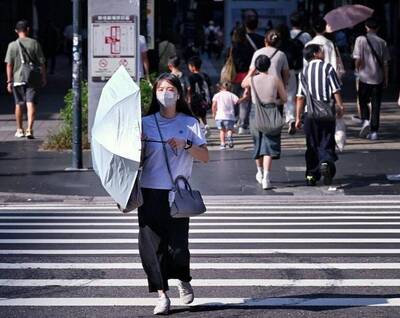Chinese tour groups are not likely to come to Taiwan until next year, Minister of Transportation and Communications Wang Kwo-tsai (王國材) told the legislature’s Transportation Committee yesterday.
“We have learned through our unofficial channel of communications that [Chinese tourists] are unlikely to come this year. We will see about next year,” Wang told Chinese Nationalist Party (KMT) Legislator Fu Kun-chi (傅崐萁).
The government has since last month allowed Chinese living or studying outside China, or in Hong Kong or Macau, to visit Taiwan for tourism.

Photo: Tu Chien-jung, Taipei Times
The Mainland Affairs Council on Aug. 24 said that it aimed to fully resume cross-strait tourism following a 30-day preparation period, and would cap the number of Chinese group travelers to Taiwan at 2,000 per day in the initial phase, adding that the same daily quota would also apply to Taiwanese tour groups traveling to China.
When cross-strait tourism could resume would depend largely on China’s response to the new policy, the council said.
However, the council said at the end of last month that it has yet to receive any official response from Beijing.
“We must be crystal clear about where we stand on cross-strait tourism issues. We have shown goodwill and would allow Taiwanese tour groups to visit China, but if Beijing only allows Taiwanese to visit China while continuing to impose a travel ban to Taiwan for Chinese group travelers, it would eventually hurt our hoteliers and restaurateurs,” Wang said.
Separately, Democratic Progressive Party Legislator Lee Kun-tse (李昆澤) blamed the Tourism Administration for a lack of growth in international visitor numbers.
The World Tourism Organization has projected that this year’s international tourism market is expected to return to at least 80 percent of pre-COVID-19 levels, up from 63 percent last year, Lee said.
The report also states that the recovery of international tourism in some countries could reach 90 percent of pre-pandemic levels this year, Lee said.
From January to August, Taiwan welcomed 3.82 million international travelers, which accounted for only 48 percent of international arrivals during the same period in 2019, Lee said.
By contrast, 7.34 million Taiwanese had traveled overseas as of August, which was 62.8 percent of the number recorded during the same period in 2019.
In Japan, the total number of inbound tourists had as of August recovered to 70 percent of the 2019 level, Lee said, citing data from the Japan National Tourism Organization.
The number of international arrivals in Japan in August returned to 86 percent of the level recorded in the same month in 2019.
Even if the Tourism Administration could manage to reach its goal of 6 million international tourists visiting Taiwan this year, it would only be 49 percent of the level recorded before COVID-19, Lee said.
Domestic tourism also showed no signs of recovery, Lee said.
The average hotel occupancy rate during the Mid-Autumn Festival long weekend was 49.28 percent, while that for the Double Ten National Day long weekend was 59.93 percent, he said.
Lee said there were several hurdles for Taiwan in attracting international tourists, including difficulties in transiting between different public transport systems, confusing road signs, a lack of characteristics in some tourist attractions and tours with low cost-performance ratios.
In response, Tourism Administration Director-General Chou Yung-hui (周永暉) said that Japan would not have mostly returned to its pre-COVID-19 levels if it discounted Chinese tourists, adding that the devaluation of the Japanese yen also prevented many Japanese from traveling overseas.
“We would increase our offices overseas, which would be in charge of conducting tourism campaigns to attract international travelers,” Chou said.

Three Taiwanese airlines have prohibited passengers from packing Bluetooth earbuds and their charger cases in checked luggage. EVA Air and Uni Air said that Bluetooth earbuds and charger cases are categorized as portable electronic devices, which should be switched off if they are placed in checked luggage based on international aviation safety regulations. They must not be in standby or sleep mode. However, as charging would continue when earbuds are placed in the charger cases, which would contravene international aviation regulations, their cases must be carried as hand luggage, they said. Tigerair Taiwan said that earbud charger cases are equipped

Foreign travelers entering Taiwan on a short layover via Taiwan Taoyuan International Airport are receiving NT$600 gift vouchers from yesterday, the Tourism Administration said, adding that it hopes the incentive would boost tourism consumption at the airport. The program, which allows travelers holding non-Taiwan passports who enter the country during a layover of up to 24 hours to claim a voucher, aims to promote attractions at the airport, the agency said in a statement on Friday. To participate, travelers must sign up on the campaign Web site, the agency said. They can then present their passport and boarding pass for their connecting international

Temperatures in northern Taiwan are forecast to reach as high as 30°C today, as an ongoing northeasterly seasonal wind system weakens, the Central Weather Administration (CWA) said. CWA forecaster Tseng Chao-cheng (曾昭誠) said yesterday that with the seasonal wind system weakening, warmer easterly winds would boost the temperature today. Daytime temperatures in northern Taiwan and Yilan County are expected to range from 28°C to 30°C today, up about 3°C from yesterday, Tseng said. According to the CWA, temperature highs in central and southern Taiwan could stay stable. However, the weather is expected to turn cooler starting tonight as the northeasterly wind system strengthens again

Taiwan sweltered through its hottest October on record, the Central Weather Administration (CWA) said yesterday, the latest in a string of global temperature records. The main island endured its highest average temperature since 1950, CWA forecaster Liu Pei-teng said. Temperatures the world over have soared in recent years as human-induced climate change contributes to ever more erratic weather patterns. Taiwan’s average temperature was 27.381°C as of Thursday, Liu said. Liu said the average could slip 0.1°C by the end of yesterday, but it would still be higher than the previous record of 27.009°C in 2016. "The temperature only started lowering around Oct. 18 or 19